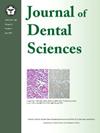Ubiquitin-like with phd and ring finger domains 1 as a potential therapeutic target in smoking-associated oral squamous cell carcinoma
IF 3.1
3区 医学
Q1 DENTISTRY, ORAL SURGERY & MEDICINE
引用次数: 0
Abstract
Background/purpose
Oral squamous cell carcinoma (OSCC) is a prevalent and aggressive malignancy with poor clinical outcomes. Epigenetic dysregulation, particularly involving the ubiquitin-like with phd and ring finger domains 1 (UHRF1), is increasingly recognized in cancer progression. However, the role of UHRF1 in OSCC and its regulation by cigarette smoking remains unclear. Therefore, the aim of this study was to investigate whether cigarette smoking influences UHRF1 expression in OSCC.
Materials and methods
UHRF1 expression was analyzed in OSCC tissues using publicly available Gene Expression Omnibus (GEO) datasets. Quantitative PCR and western blotting were employed to evaluate UHRF1 levels in OSCC cell lines. Functional assays, including colony formation, wound healing, and transwell invasion, were conducted following UHRF1 knockdown or overexpression. To investigate the impact of cigarette smoking on UHRF1 expression, cells were treated with cigarette smoke condensate (CSC) in a time-dependent manner. In vivo, a xenograft mouse model was used to assess the effect of CSC treatment on tumor growth and UHRF1 expression.
Results
As compared to normal tissue, UHRF1 was significantly overexpressed in OSCC tissues. Functional assays revealed that UHRF1 promotes OSCC cell proliferation, migration, and invasion. CSC treatment upregulated UHRF1 expression in vitro and enhanced tumor growth in vivo. Immunohistochemical analysis of xenograft tumors confirmed elevated UHRF1 expression following CSC exposure.
Conclusion
This study provides the first evidence that UHRF1 functions as an oncogenic driver in OSCC and may mediate smoking-induced tumorigenesis. These findings highlight UHRF1 as a potential biomarker and therapeutic target, particularly in smoking-associated OSCC.
泛素样phd和无名指结构域1作为吸烟相关口腔鳞状细胞癌的潜在治疗靶点
背景/目的口腔鳞状细胞癌(OSCC)是一种常见的侵袭性恶性肿瘤,临床预后较差。表观遗传失调,特别是涉及泛素样博士和环指结构域1 (UHRF1),在癌症进展中越来越被认识到。然而,UHRF1在OSCC中的作用以及吸烟对OSCC的调节尚不清楚。因此,本研究的目的是探讨吸烟是否影响UHRF1在OSCC中的表达。材料和方法使用公开的Gene expression Omnibus (GEO)数据集分析suhrf1在OSCC组织中的表达。采用定量PCR和western blotting检测细胞中UHRF1水平。在UHRF1敲低或过表达后进行功能检测,包括菌落形成、伤口愈合和跨井侵袭。为了研究吸烟对UHRF1表达的影响,我们用香烟烟雾冷凝物(CSC)以时间依赖的方式处理细胞。在体内,采用异种移植小鼠模型来评估CSC治疗对肿瘤生长和UHRF1表达的影响。结果与正常组织相比,UHRF1在OSCC组织中显著过表达。功能分析显示UHRF1促进OSCC细胞增殖、迁移和侵袭。在体外,CSC治疗上调了UHRF1的表达,并促进了体内肿瘤的生长。异种移植肿瘤的免疫组织化学分析证实了CSC暴露后UHRF1表达升高。结论本研究首次证实UHRF1在OSCC中起致癌驱动作用,并可能介导吸烟诱导的肿瘤发生。这些发现强调了UHRF1作为潜在的生物标志物和治疗靶点,特别是在吸烟相关的OSCC中。
本文章由计算机程序翻译,如有差异,请以英文原文为准。
求助全文
约1分钟内获得全文
求助全文
来源期刊

Journal of Dental Sciences
医学-牙科与口腔外科
CiteScore
5.10
自引率
14.30%
发文量
348
审稿时长
6 days
期刊介绍:
he Journal of Dental Sciences (JDS), published quarterly, is the official and open access publication of the Association for Dental Sciences of the Republic of China (ADS-ROC). The precedent journal of the JDS is the Chinese Dental Journal (CDJ) which had already been covered by MEDLINE in 1988. As the CDJ continued to prove its importance in the region, the ADS-ROC decided to move to the international community by publishing an English journal. Hence, the birth of the JDS in 2006. The JDS is indexed in the SCI Expanded since 2008. It is also indexed in Scopus, and EMCare, ScienceDirect, SIIC Data Bases.
The topics covered by the JDS include all fields of basic and clinical dentistry. Some manuscripts focusing on the study of certain endemic diseases such as dental caries and periodontal diseases in particular regions of any country as well as oral pre-cancers, oral cancers, and oral submucous fibrosis related to betel nut chewing habit are also considered for publication. Besides, the JDS also publishes articles about the efficacy of a new treatment modality on oral verrucous hyperplasia or early oral squamous cell carcinoma.
 求助内容:
求助内容: 应助结果提醒方式:
应助结果提醒方式:


